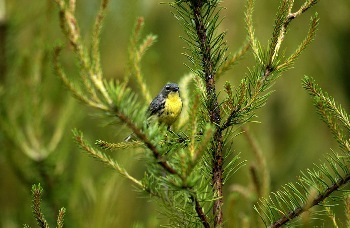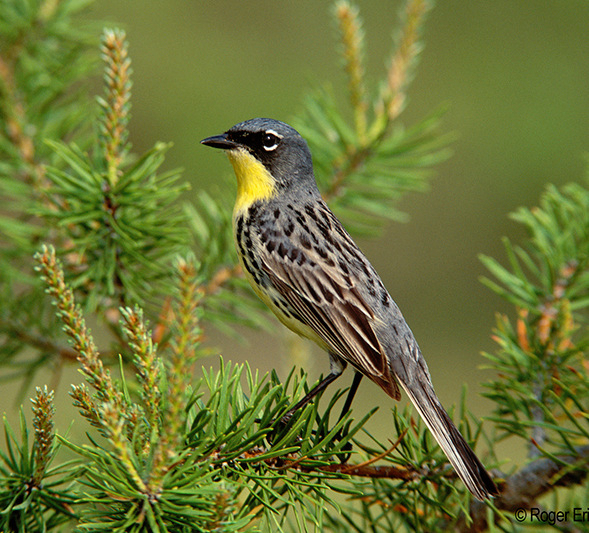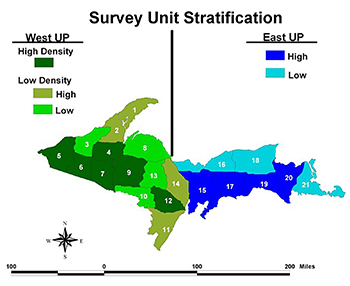Michigan’s Kirtland’s warbler reached record-high numbers in 2012
 The Department of Natural Resources (DNR) recently released Michigan’s annual survey information indicating the population of Kirtland’s warbler, a federally endangered bird, has reached an all-time high.
The Department of Natural Resources (DNR) recently released Michigan’s annual survey information indicating the population of Kirtland’s warbler, a federally endangered bird, has reached an all-time high.
“We are witnessing a conservation success story,” said DNR endangered species coordinator Dan Kennedy.
Biologists, researchers and volunteers in Michigan observed 2,063 singing males during the official 2012 survey period – 1,805 males were observed in 2011. This represents the largest single-year increase since 2007. The lowest numbers were recorded in 1974 and 1987, when only 167 singing males were found.
This year, singing males (numbers in parentheses) were found in 12 northern Lower Peninsula counties: Antrim (2), Alcona (266), Clare (40), Crawford (322), Iosco (248), Kalkaska (72), Montmorency (63), Ogemaw (540), Oscoda (388), Otsego (11), Presque Isle (24) and Roscommon (49). Surveyors identified 38 singing males in seven Upper Peninsula counties: Alger (4), Baraga (2), Chippewa (13), Delta (5), Luce (3), Marquette (4) and Schoolcraft (7). Twenty-seven additional singing males were observed outside Michigan in Wisconsin (23) and Ontario (4).
The Kirtland’s warbler survey is conducted during the second and third weeks of June, when the birds are defending their nesting territories. Warblers are detected by listening for their songs, which can be heard at distances up to one-quarter mile, providing an excellent way to detect the birds with minimum disturbance. Only the males sing, so estimates of breeding population size are obtained by doubling the number of singing males recorded, based on the assumption that each male has a mate in its territory.
The 2012 survey was a joint effort between the DNR, the U.S. Forest Service, the U.S. Fish and Wildlife Service, the Michigan Department of Military and Veterans Affairs, the Michigan Audubon Society and citizen volunteers. “The record census results we have observed this year are testament to the extraordinary habitat management work of many individuals and DNR partners,” said Kennedy.
Kirtland’s warblers typically nest on the ground in stands of jack pine between 4 and 20 years old. Historically, these stands of young jack pine were created by natural wildfires that frequently swept through northern Michigan. Modern fire suppression programs altered this natural process, reducing Kirtland’s warbler habitat. As a result, the population of Kirtland’s warblers declined to the point that they were listed as endangered.
To mimic the effects of wildfire and ensure the future of this species, the DNR, the U.S. Forest Service and the U.S. Fish and Wildlife Service manage the forests through a combination of timber harvests, burning, seeding and replanting to promote habitat for many species, including snowshoe hare, white-tailed deer, other songbird species and rare plants. Because large prescribed fires are neither safe nor economical in northern Michigan, approximately 3,000 acres of jack pine trees are harvested and replanted annually on state and federal lands. This use of public lands creates jobs, provides habitat for Kirtland’s warblers and other species, and brings birders and hunters from across the state and around the world to northern Michigan.
“The Kirtland’s warbler program is not just for the benefit of an endangered bird,” said DNR wildlife biologist Keith Fisher. “This program provides local economic benefits such as wood-products jobs and tourism, while at the same time supplying excellent habitat for a variety of plant and wildlife species.”
For more information on the Kirtland’s warbler, visit www.michigan.gov/wildlife and click on Wildlife Species, then Birds.





